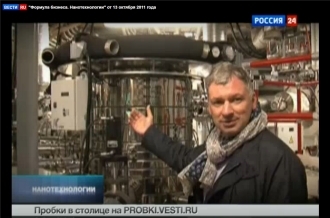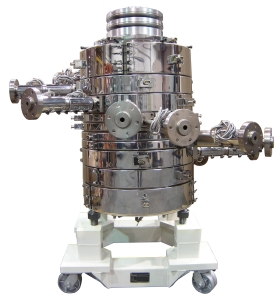 |
 |
January 2012 DSS Supplies 10 Layer Die, a Russian First!
 Dual Spiral Systems has supplied, the first and so far only 10 layer, 10 extruder blown film die in Russia. The line was tested in the 4th quarter of 2011. Dual Spiral Systems has supplied, the first and so far only 10 layer, 10 extruder blown film die in Russia. The line was tested in the 4th quarter of 2011.
Films being produced on this line are next generation nanocomposite barrier films for food packaging.
Films using nanocomposites can increase the shelf life of packaged products. The intended application here is to produce package films for ready-made meals, which previously used traditional metal foil laminated to coextruded film resulting in a shelf life of 6 to 24 months. With nanocomposite film, ready-made meals can now be stored up to 5 years without preservatives.
Now, with the absence of the foil layer, these packaged ready-made meals can be microwaved right in the package. Because of the elimination of the lamination process, nanocomposite barrier films are said to be less expensive to produce than traditional foil/coex structures.
End users of the film, who previously imported barrier films, now have access to domestically produced high barrier packaging film, whose properties exceeds previously available imported film.
 Dual Spiral Systems die technology was an ideal fit for nanocomposite barrier film production. DSS dies employ layer splitting which multiplies the number of layers being produces. One of the effects of DSS layer splitting is an increase in the strength film through the "plywood effect" meaning that a 2-ply film will be stronger than a single ply film of the same overall thickness. The same premise applies to gas barrier property. As the number of layers increases the number of interfaces between barrier layers also increases, hence providing a higher overall barrier property of the layer split film. Dual Spiral Systems die technology was an ideal fit for nanocomposite barrier film production. DSS dies employ layer splitting which multiplies the number of layers being produces. One of the effects of DSS layer splitting is an increase in the strength film through the "plywood effect" meaning that a 2-ply film will be stronger than a single ply film of the same overall thickness. The same premise applies to gas barrier property. As the number of layers increases the number of interfaces between barrier layers also increases, hence providing a higher overall barrier property of the layer split film.
The barrier property of a split barrier layer film will always be better compared to coex with a single barrier layer of the same material and same total thickness of barrier resin. The reason is the energy required for oxygen penetration, into the barrier layer is a different value (higher) compared to the energy required for transition through the barrier layer. Each interface affects the barrier resulting in a lower permeation rate. The permeation rate is further decreased by the use of nanocomposite barrier layers within the film structure.
|
 |
|